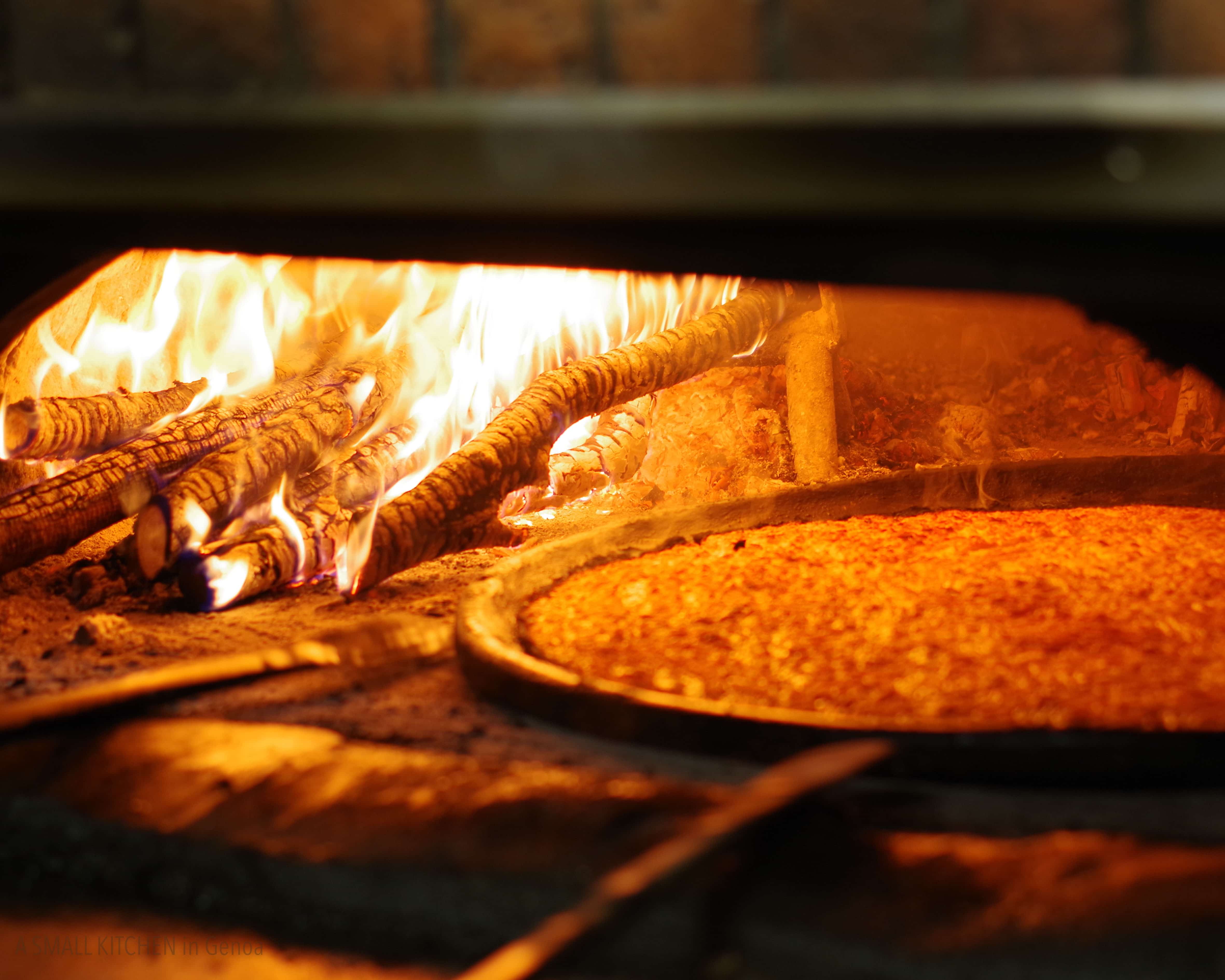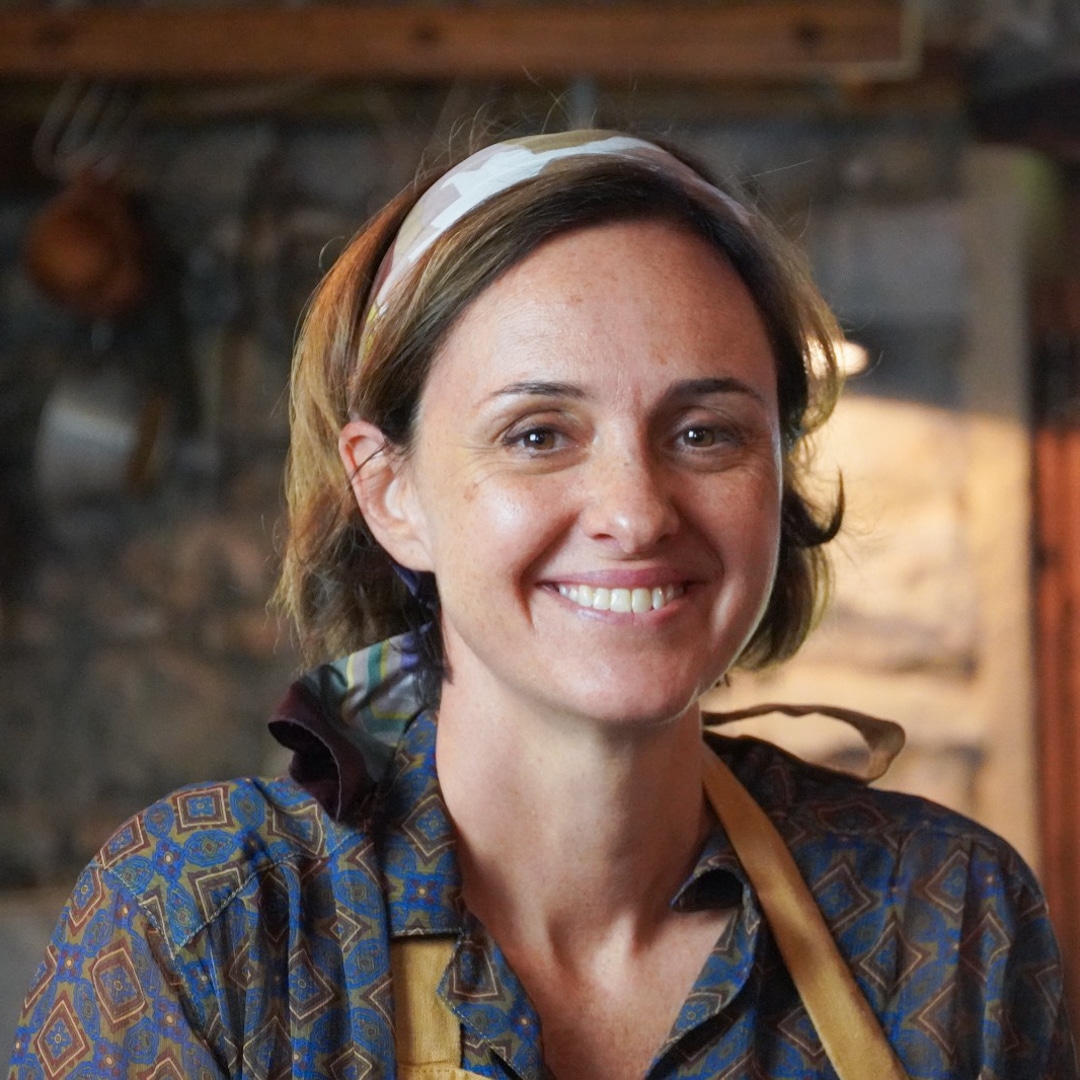
I have always had a conflictual relationship with farinata, the famous Genoa chickpea tart. Sincere and dispassionate love when bought already made, deep hate mixed with discomfort when I prepared it at home. Yes, I’ve neve been able to properly bake a farinata. Too high, too thin, burnt on top, raw at the base, and vice versa, or “decomposed” into a thousand of greasy bubbles… and so on. A clear culinary frustration because if you read the recipe it seems the simplest thing in the world: make a batter with water and chickpea flour, let it rest, pour it over an oiled baking pan and bake in the hot oven. That’s it, easy isn’t it? So the problem had always been me. And since I already had enough frustrations I had decided that we could buy our farinata from the bakery near our house, fairy good by the way.
Making farinata has always been a thorn in my side until someone taught me how to do it. It is true that experience shows but it is also true that those who have more experience than you can show you, and you certainly gain self-esteem!
Tricks to prepare a perfect farinata
Without other preambles (I’ll tell you the story of the farinata at the end of the recipe), here are the tricks to prepare a perfect farinata like the one sold in Genoa downtown alleys:
- The proportions between the ingredients are fixed and invariable. 75% water, 25% chickpea flour and, on total, 1-0,8% salt and 12-10% oil.
- The thickness of the chickpea tart is fundamental. It must be between 0.7 and 0.9 cm. Only the right amount of batter inside the pan guarantees that your farinata cooking remains moist underneath, cooked in the center and crispy above. For this reason, to each baking pan corresponds a quantity of batter and, consequently, different doses of ingredients. Here is a summary scheme (for a lighter result, less salty and oily, you can lower the amounts of salt and oil of 10% in the amounts below ) :

- The perfect pan is round and in copper. Copper is in fact an excellent thermal conductor. The farinata, however, comes out good even in normal trays, even in the disposable one in aluminum!
- The batter, without lumps, must rest at least 4 hours, better 8, at room temperature. The flour must absorb the water very well. Mix it every 2 hours and remove the foam that eventually forms on top (these are the impurities that the chickpeas release).
- Salt should be added at the end, just before pouring the batter of your farinata into the pan.
- No oil in the mixture. The oil – which can also be simple olive oil (yes, I know, the purists of extra virgin olive oil will quiver but the extra virgin olive oil with its taste so decided in cooking is likely to overpower all other flavors) – must only form a protective film inside the pan and cover over and under the batter. For this fundamental step some precautions are necessary: the pan must be already hot before pouring the oil, and then the farinata, inside; the farinata batter must be poured very slowly making it slide along a spoon placed in the center of the pan. In this way it will float over the oil without breaking its surface or mixing with it. The oil will then rise along the edges and cover the batter even on the surface. This will create a sort of “pajam” of oil that wraps the batter.
- The oven must be very hot. The optimal temperature would be 300°C (570°F) but not all the home ovens reach it. So you set the maximum temperature and bake it in the lower shelf of the oven for 20-25 minutes (the time depends on the size of the pan) or until the farinata has turned golden. Then you Ttrn off the oven and turn on the grill function for 5 minutes to obtain a nice nut-colored crust on the surface.
- Farinata MUST be eaten warm. This is the biggest advantage in preparing it at home! Once baked, sprinkle with black pepper, wait a minute and then serve!
- You can season/empower farinata with some toppings before baking: rosemary springs, gorgonzola cheese, small whitebait or – when in season – with finely sliced fresh artichokes, which is my favorite variation!




Ingredients
for a 35cm diameter pan
- 190 g of chickpea flour
- 570 cc of lukewarm water
- 8 g of salt
- 90 g of olive oil
Instructions
- Put the chickpea flour in a bowl and add lukewarm water a little at a time stirring with a whisk so that a smooth and lump-free batter is created.
- Let it rest at room temperature covered with transparent film for at least 4 hours (better 8).
- Mix it every 2 hours and remove the foam that eventually forms on top (these are the impurities that release the chickpeas).
- When the batter is ready, preheat the oven to 280°C - 300°C (530-570°F) and put the empty pan inside.
- Add salt to the batter and stir.
- Take the pan from the oven, be careful not to burn, and pour in the oil.
- Then take a wooden spoon, place it at an angle of 45 ° in the center of the pan and pour the batter inside the pan making it run along the spoon (the batter will gently float over the oil and the oil will create a protective film above and under the batter without mixing with it).
- Bake in the lower shelf of the oven and cook for 20 minutes or until the farinata will not have a light hazelnut color.
- Then turn off the oven and turn on the grill mode for 5 minutes to create a light brown crust on the surface.
- Remove from the oven, wait a minute, sprinkle with pepper and serve hot.
Brief history of farinata
Farinata is one of the most representative dishes of Genoese street food. It is an ancient dish so popular that the Genoese give it a legend to remember one of the greatest achievements in the city’s history: the defeat of the Pisans in the Meloria battle (Pisa too was a Maritime Republic and it was a great rival of Genoa for the dominance over Corsica and Sardinia).
The year was 1284. It is said that on the return from the battle the Genoese fleet encountered a storm. The bags of chickpea flour on board the ships overturned and the flour mixed with the sea water that swept the decks. After the storm the sailors, exhausted and hungry, recovered the batter and put it to dry in the sun. The next day they tasted it and discovered its goodness. When they got home, they refined the recipe baking it in wood ovens and, in defiance of the won enemy, they called it “the gold of Pisa”.
A legend, certainly, because farinata dates back to Roman times and similar dishes – based on water and chickpea flour – are also typical of other Mediterranean regions: in Tuscany, in Pisa – in fact – you can eat cecina, in Livorno a cake of chickpeas, in Sardinia the fainé, in Sicily there are the famous panelleand in Provence a tart very similar to farinata and called socca. In short, the chickpea flour over the centuries has fed and conquered so many seafaring peoples!
Where to buy farinata in Genoa
If you are passing through Genoa, here are some places where I recommend to buy it:





JOIN ME ON MY FOOD JOURNEY
Get my monthly newsletter with fresh recipes, my latest food adventures, upcoming events, and lots more from the sunny Italian Riviera!





